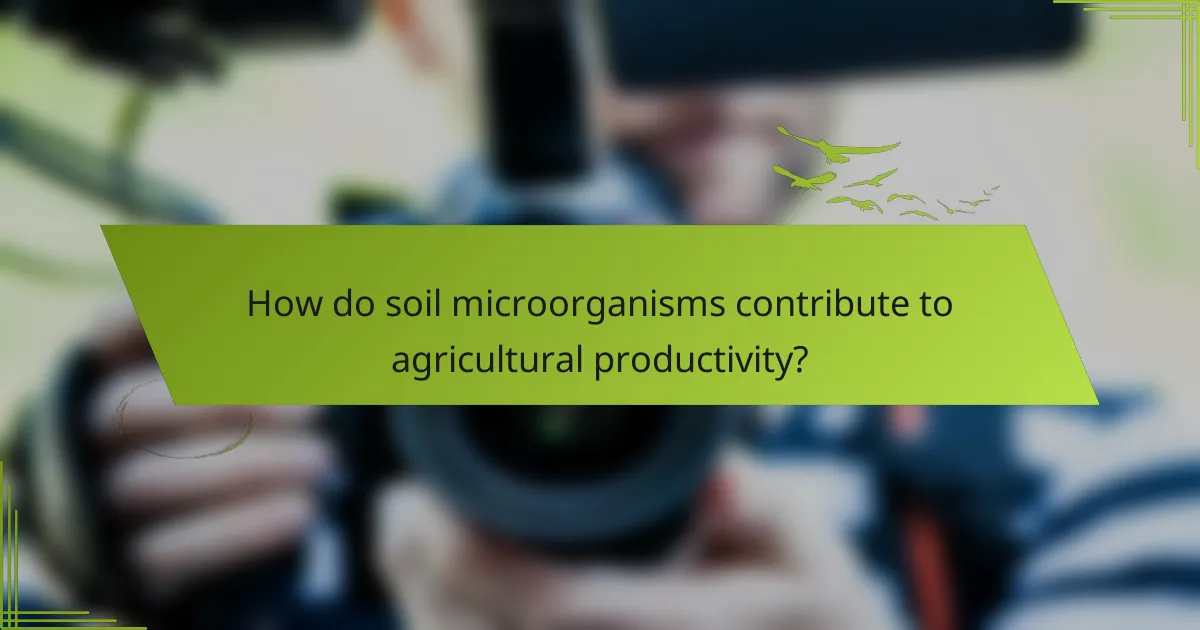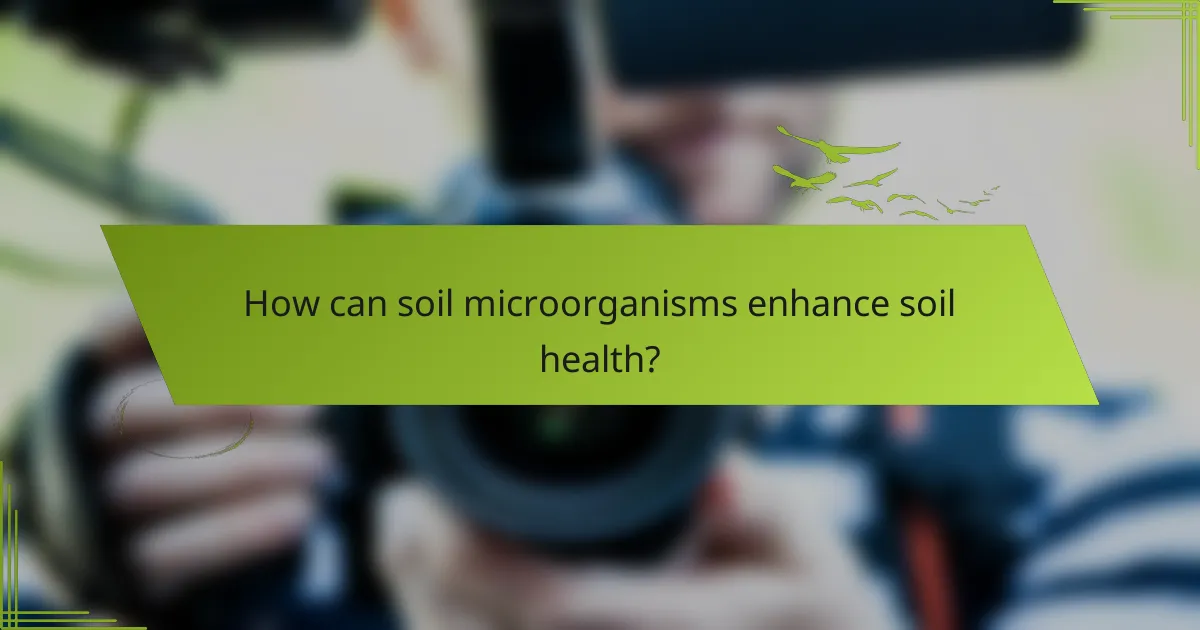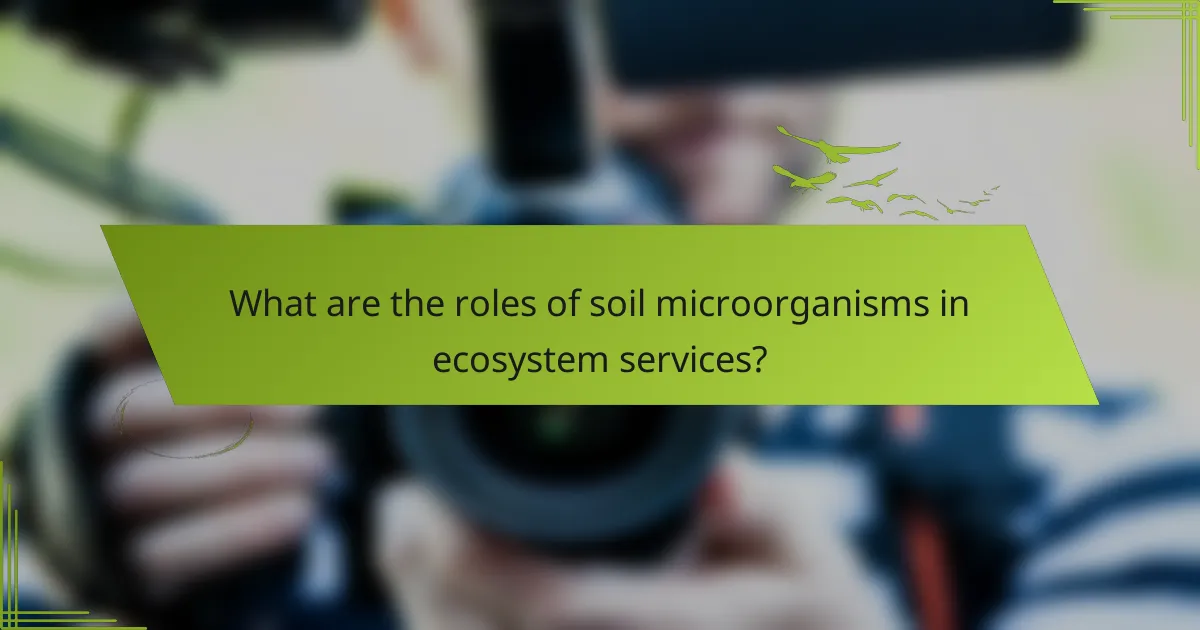Soil microorganisms are essential for maintaining healthy ecosystems and enhancing agricultural productivity. They facilitate nutrient cycling, improve soil structure, and suppress pests and diseases, contributing significantly to soil health and fertility. The diverse roles of bacteria, fungi, and protozoa ensure a balanced environment that supports robust crop growth and sustainable farming practices.

How do soil microorganisms contribute to agricultural productivity?
Soil microorganisms play a crucial role in enhancing agricultural productivity by facilitating nutrient availability, improving soil structure, and suppressing pests and diseases. Their diverse functions are essential for maintaining healthy soil ecosystems that support crop growth.
Nutrient cycling
Soil microorganisms are integral to nutrient cycling, breaking down organic matter and releasing essential nutrients like nitrogen, phosphorus, and potassium into the soil. This process ensures that plants have access to the nutrients they need for optimal growth.
Microbial activity can significantly increase nutrient availability, with some studies indicating that healthy soil can contain up to 50% more accessible nutrients compared to degraded soil. Farmers can enhance nutrient cycling by incorporating organic matter, such as compost or cover crops, which stimulate microbial populations.
Soil structure improvement
Soil microorganisms contribute to soil structure improvement by producing substances that bind soil particles together, creating aggregates. These aggregates enhance soil aeration, water retention, and root penetration, all of which are vital for plant health.
For example, mycorrhizal fungi form symbiotic relationships with plant roots, increasing the soil’s ability to hold moisture and nutrients. Farmers can promote beneficial microbial activity by minimizing soil disturbance and using no-till practices, which help maintain soil structure and health.
Pest and disease suppression
Soil microorganisms help suppress pests and diseases by outcompeting harmful pathogens for resources and producing natural antibiotics. This biological control reduces the need for chemical pesticides, leading to more sustainable farming practices.
For instance, certain bacteria and fungi can inhibit the growth of root rot pathogens, protecting crops from disease. To leverage this benefit, farmers should focus on maintaining diverse microbial communities through crop rotation and organic farming practices, which enhance the natural resilience of the soil ecosystem.

What types of soil microorganisms are most beneficial?
The most beneficial soil microorganisms include bacteria, fungi, and protozoa, each playing a crucial role in maintaining soil health and fertility. These microorganisms contribute to nutrient cycling, organic matter decomposition, and overall ecosystem balance.
Bacteria
Bacteria are the most abundant microorganisms in soil, often numbering in the billions per gram. They are essential for breaking down organic matter and recycling nutrients, particularly nitrogen, phosphorus, and sulfur, which plants need to thrive.
Different types of bacteria perform specific functions; for example, nitrogen-fixing bacteria convert atmospheric nitrogen into forms usable by plants. To enhance bacterial activity, maintain soil moisture and avoid excessive use of chemical fertilizers that can disrupt their populations.
Fungi
Fungi, including mycorrhizal fungi, form symbiotic relationships with plant roots, aiding in nutrient absorption, particularly phosphorus. They also help decompose complex organic materials, enriching the soil with nutrients and improving its structure.
To promote beneficial fungi, practice crop rotation and minimize soil disturbance. Incorporating organic matter, such as compost, can also support fungal growth and enhance soil health.
Protozoa
Protozoa are single-celled organisms that feed on bacteria and organic matter, playing a key role in regulating bacterial populations and nutrient cycling. They help release nutrients in forms that plants can absorb, thus supporting plant growth.
To foster a healthy protozoan population, maintain a diverse soil ecosystem and avoid practices that lead to soil compaction or erosion. Regularly adding organic materials can help sustain their populations and improve soil fertility.

How can soil microorganisms enhance soil health?
Soil microorganisms play a crucial role in enhancing soil health by improving nutrient availability, promoting soil structure, and fostering a balanced ecosystem. Their activities contribute to the overall fertility and sustainability of soil, making it vital for plant growth and agricultural productivity.
Organic matter decomposition
Soil microorganisms are essential for the decomposition of organic matter, breaking down plant and animal residues into simpler compounds. This process releases nutrients like nitrogen, phosphorus, and potassium, which are vital for plant growth. Effective decomposition can increase soil organic carbon levels, enhancing soil fertility.
To promote organic matter decomposition, maintain a diverse microbial community by adding compost or organic fertilizers. Avoid excessive tillage, which can disrupt microbial habitats and slow down decomposition rates.
Soil aeration
Soil microorganisms contribute to soil aeration by creating channels and pores through their activities. This improves air circulation within the soil, allowing roots to access oxygen and facilitating the movement of water and nutrients. Well-aerated soil supports healthier plant growth and reduces the risk of root diseases.
To enhance soil aeration, incorporate organic matter such as mulch or compost, which encourages microbial activity. Avoid compacting the soil through heavy machinery or foot traffic, as this can hinder microbial functions and reduce aeration.
Water retention
Soil microorganisms enhance water retention by forming aggregates that improve soil structure, allowing it to hold moisture more effectively. This is particularly important in regions with variable rainfall, as it helps maintain consistent moisture levels for plants. Healthy microbial populations can significantly increase the soil’s water-holding capacity.
To improve water retention, focus on building organic matter content through practices like cover cropping and mulching. These methods support microbial life and create a more resilient soil structure that retains moisture longer.

What are the roles of soil microorganisms in ecosystem services?
Soil microorganisms play crucial roles in ecosystem services by enhancing soil health, promoting plant growth, and supporting nutrient cycling. Their activities contribute to carbon storage, assist in pollination processes, and facilitate the breakdown of pollutants, thereby maintaining ecological balance.
Carbon sequestration
Soil microorganisms are vital for carbon sequestration, as they help convert organic matter into stable forms of carbon stored in the soil. This process not only reduces greenhouse gases in the atmosphere but also improves soil fertility. Practices like cover cropping and reduced tillage can enhance microbial activity, leading to increased carbon storage.
For effective carbon sequestration, consider incorporating diverse plant species that support a variety of microorganisms. This diversity can enhance the soil’s ability to capture and retain carbon over time.
Pollination support
Soil microorganisms indirectly support pollination by promoting healthy plant growth and flowering, which attracts pollinators. Healthy soil ecosystems provide the nutrients necessary for plants to thrive, leading to more abundant and diverse floral resources for pollinators. This relationship is crucial for agricultural productivity and biodiversity.
To enhance pollination support, maintain soil health through practices such as organic amendments and crop rotation. These methods foster a robust microbial community that benefits both plants and pollinators.
Bioremediation
Bioremediation involves using soil microorganisms to degrade environmental contaminants, making them an essential tool for cleaning up polluted sites. Microbes can break down various pollutants, including heavy metals and hydrocarbons, transforming them into less harmful substances. This natural process is often more sustainable and cost-effective than traditional remediation methods.
When considering bioremediation, assess the specific contaminants present and select microbial strains known for their effectiveness in degrading those pollutants. Monitoring microbial activity can help evaluate the success of the remediation efforts.

How can farmers promote beneficial soil microorganisms?
Farmers can promote beneficial soil microorganisms by implementing practices that enhance soil health and biodiversity. Strategies such as cover cropping, reduced tillage, and applying organic amendments can significantly improve microbial activity and diversity in the soil.
Cover cropping
Cover cropping involves planting specific crops during the off-season to protect and enrich the soil. These crops, such as clover or rye, can enhance soil structure, reduce erosion, and provide organic matter when decomposed, which supports microbial populations.
Farmers should select cover crops that are well-suited to their local climate and soil conditions. Ideally, cover crops should be planted before the main growing season and terminated before planting cash crops to maximize benefits without competing for resources.
Reduced tillage
Reduced tillage minimizes soil disturbance, which helps maintain the habitat for beneficial microorganisms. This practice preserves soil structure and organic matter, allowing microbial communities to thrive and perform essential functions such as nutrient cycling.
Farmers can adopt no-till or minimum-till practices to enhance soil health. It’s important to monitor soil moisture and compaction levels, as these factors can influence the effectiveness of reduced tillage methods.
Organic amendments
Applying organic amendments, such as compost or manure, enriches the soil with nutrients and improves microbial diversity. These amendments provide a food source for microorganisms, promoting their growth and activity, which in turn benefits plant health.
Farmers should consider the nutrient content and potential pathogens in organic amendments. It’s advisable to apply well-composted materials to avoid introducing harmful organisms and to follow local regulations regarding application rates and timing.

What are the challenges facing soil microorganisms?
Soil microorganisms face several significant challenges that threaten their diversity and ecosystem roles. These challenges include soil degradation, climate change impacts, and pesticide effects, all of which can disrupt their populations and functions.
Soil degradation
Soil degradation refers to the decline in soil quality due to various factors, including erosion, compaction, and nutrient depletion. This degradation can lead to a loss of habitat for microorganisms, reducing their diversity and effectiveness in nutrient cycling and organic matter decomposition.
Practices such as monoculture farming and excessive tillage exacerbate soil degradation. To combat this, land management strategies like crop rotation, cover cropping, and reduced tillage can help restore soil health and support microbial communities.
Climate change impacts
Climate change poses a significant threat to soil microorganisms through altered temperature and moisture levels. Increased temperatures can accelerate microbial metabolism, potentially leading to faster decomposition of organic matter and nutrient loss from the soil.
Additionally, changes in precipitation patterns can create conditions that either promote or hinder microbial activity. Implementing adaptive management practices, such as improving soil moisture retention through organic amendments, can help mitigate these impacts.
Pesticide effects
Pesticides can have detrimental effects on soil microorganisms, disrupting their populations and reducing biodiversity. Many pesticides are designed to target specific pests but can inadvertently harm beneficial microbes that play crucial roles in soil health.
To minimize pesticide impacts, consider integrated pest management (IPM) strategies that reduce reliance on chemical controls. Utilizing biological controls and promoting natural pest predators can help maintain a balanced soil ecosystem while protecting microbial communities.
